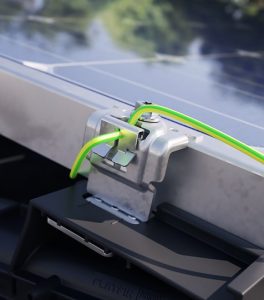
The FlatFix Fusion line has been on the market since 2014 and was Esdec’s first modular flat roof mounting system. By immediately setting a high standard, in terms of flexibility as well as finishing and processing, this mounting system has earned its place in the market. To keep the system state-of-the-art, Esdec recently released an update to several components in the FlatFix Fusion line. Improvements that not only make it easier for the installer to install, but also make the PV system a lot safer. We take you through all the new gadgets and frequently asked questions about this system!
We sometimes hear: what is the difference between the FlatFix mounting systems Fusion and Wave Plus? We can be very brief about that: Fusion is an extremely flexible mounting system for smaller and medium-sized flat roofs, both residential and commercially applicable. Despite the smaller surface area, these roofs often have various cooling and ventilation units and other obstacles. Fusion allows you to lay the PV system around these obstacles very flexibly and easily. Wave Plus has been developed for the larger commercial roofs. During the development we really looked at the fast, error-free installation of the large numbers of running meters of mounting system. So, this is about making meters in straight lines.
Where the FlatFix Wave mounting system is mainly constructed from robust steel, FlatFix Fusion combines the positive properties of different materials to create a light and flexible mounting system. For example, the aluminum profiles and steel ballast boxes ensure the rigidity of the system. The flexibility of the system is realized by using plastic parts at crucial points. The advantage is that you can injection mold plastic in all kinds of shapes that fit perfectly with the aluminum profiles. The combination of the use of aluminum and plastic makes it a lightweight system, making it easy to carry on the roof. This also gives a lot of flexibility in placing the right ballast in the desired places. In addition, the system is available in both aluminum and full black, which makes it an aesthetically pleasing addition to the exterior on residential roofs. Last but not least: aluminum and plastic cannot rust and do not “bite each other”.


By using plastic parts where we need maximum flexibility, we get the possibility to make specific functions, feet and connectors. If we take the plastic roof supports on which the solar panel is fixed via the base element, we see that these roof supports are attached to the high and low base with a movable coupling. The aluminum edge profiles of the solar panels and the roofing shrink and expand when temperature differences occur. If the mounting system does not absorb this, damage to the roof covering and construction can occur. Instead of preventing this so-called caterpillar effect, FlatFix Fusion is designed to deal with shrinkage and expansion. Because the roof supports can move from the movable coupling, the system slides over the roof support. This automatically decouples the system thermally when necessary and prevents damage to the roof.
The plastic is not just any plastic. It is not a plastic that is used in kitchen or garden equipment, it meets high industrial requirements. For example, the plastic used has a high UV stability, so that no degradation occurs. The quality will therefore remain the same in 20 years. Furthermore, there are no substances in our plastic components that react with plasticizers, so that it does not affect the roof covering.
To prevent voltage differences in a PV system, you use the potential equalization to connect all parts that can conduct current. Bonding of all PV modules in a row can be achieved by using the FlatFix Fusion universal module clamp. Previously, to bond the solar panels with each other, FlatFix Fusion always used the grounding rings under the panels. This grounding ring has since been replaced by the universal module clamp. Thanks to the new universal module clamp, this step is integrated in the installation of the clamps, so no additional handling or part is required. The sharp edges of the ground rings and/or the connection terminals cut through the hard outer layer (by e.g. oxidation, anodization or paint) of the PV module frame, achieving a robust and durable electrical connection. By placing the universal module clamp, all PV modules in a row are immediately ‘connected’ to each other.
To continue the permanent bonding in the grounding, the multi-core 6mm2 grounding cable made of tin-plated copper is used, which connects to the grounding rail via the grounding clip that fits in the end clamp.


Esdec’s research & development department is continuously looking for opportunities not only to develop new products, but also to make existing products even better. And of course we listen carefully to installers who use the system.
In our virtual showroom you can view all our mounting systems virtually in the Esdec Innovation Center.